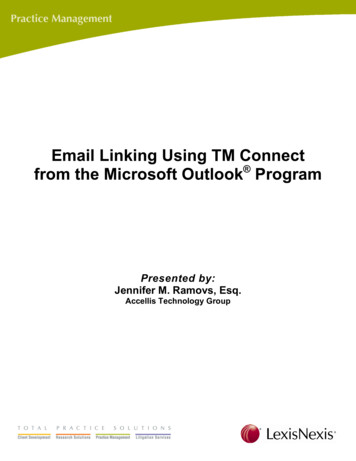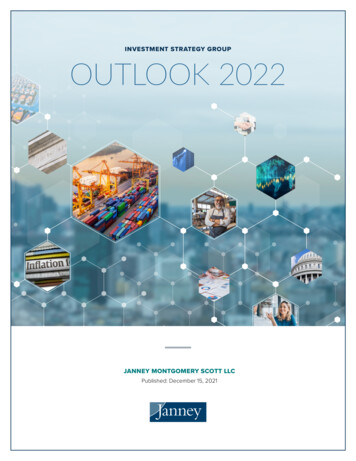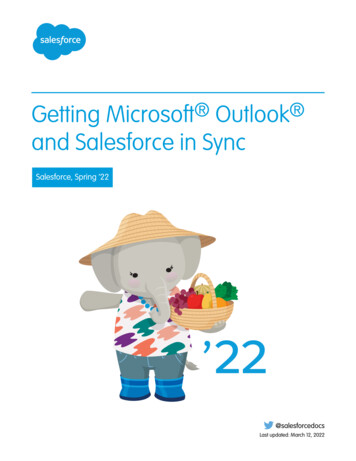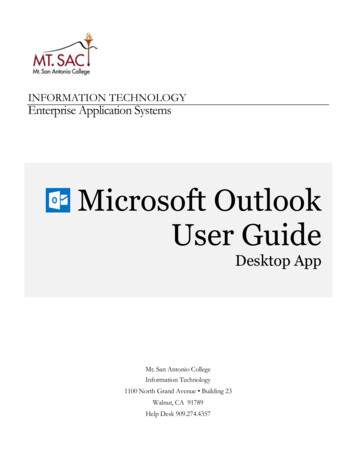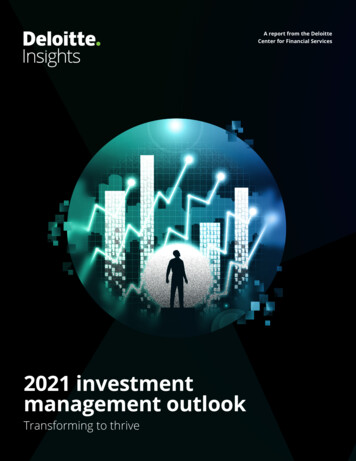
Transcription
A report from the DeloitteCenter for Financial Services2021 investmentmanagement outlookTransforming to thrive
About the Deloitte Center for Financial ServicesThe Deloitte Center for Financial Services, which supports the organization’s US Financial Servicespractice, provides insight and research to assist senior-level decision-makers within banks, capitalmarkets firms, investment managers, insurance carriers, and real estate organizations. The center isstaffed by a group of professionals with a wide array of in-depth industry experiences as well ascutting-edge research and analytical skills. Through our research, roundtables, and other forms ofengagement, we seek to be a trusted source for relevant, timely, and reliable insights. Read recentpublications and learn more about the center on Deloitte.com.ConnectTo learn more about the vision of the DCFS, its solutions, thought leadership, and events, please visitwww.deloitte.com/us/cfs.SubscribeTo receive email communications, please register at www.deloitte.com/us/cfs.EngageFollow us on Twitter at: @DeloitteFinSvcs.As global leaders in providing services to the investment management industry, Deloitte’sInvestment Management practice provides global resources and capabilities with a localpresence, resulting in a clear understanding of each client’s specific market and way of doingbusiness. To learn more, visit Deloitte.com.
ContentsTransforming to thrive 3The outlook 5Three perspectives on the investment management outlook 6Pressure catalyzes prudent transformation 17Endnotes 18
2021 investment management outlookKEY MESSAGES1. According to the results of our proprietary survey conducted over the summer of 2020,most investment management firms indicate they have more to do in both thedevelopment of agile back-to-the-workplace plans and communication of their plans, tohelp employees feel more comfortable.2. Our survey results indicate that firms are taking multiple approaches to managingworkforce costs, and that most actions were taken by the summer of 2020. The incidenceof furloughs at the same rate as layoffs indicates both optimism for a recovery on thepart of leadership and creativity to deploy less-utilized approaches to manage theworkforce through COVID-19.3. Overall, most investment management firms seem to be changing approaches to digitaltransformation to support cost savings. The spending allocations by technology are alsochanging in ways that appear to support the security and efficiency of digital interaction.Some investment management firms are decreasing emphasis on digital transformationenabled through both vendor solutions and in-house build projects.4. Digital transformation could become an element in many investment management firms’brands. Like it or not, investors may judge investment management firms on thesophistication and elegance of their customer interactions.5. The experience gained weathering the volatility and personal hardship, along with theindustry’s commitment to both customers and employees, will likely lead to a stronger,more digitally capable investment management industry at the end of 2021.2
Transforming to thriveTransforming to thriveTHE COVID-19 PANDEMIC was the globalBefore the world turned upside down, thestory for 2020, but how firms recover frominvestment management industry wasthe pandemic and thrive in a post-COVID-19experiencing two important forces: the longestworld is expected to be the story for the investmentrunning bull market in history and shrinkingmanagement industry for 2021. Industry impactmargins at all but the most successful investmentfrom COVID-19 varied widely, with investmentmanagement firms.1 The market correction frommanagement as a whole sustaining less damageFebruary to March ended the bull market run,than some other sectors of the economy. Revenueswhile operations were simultaneously thrown intofor investment management firms remained largelyturmoil by stay-at-home orders in the face ofintact, but the people, the operations, and thegrowing case counts of COVID-19. The markettechnology used by investment managers werecorrection was short lived, but the subsequentimpacted. At the same time, market volatility andrecovery activities undertaken continue today atprice movement dramatically accelerated at themany firms.industry sector and asset class levels.The COVID-19 pandemic was the global story for 2020,but how firms recover from the pandemic and thrive ina post-COVID-19 world is expected to be the story forthe investment management industry for 2021.3
2021 investment management outlookAs we look at the assets under management (AUM)AUM in the United States. Globally, thein the investment management industry and theirperformance of active equity managers over thelong-term growth rates, the year-end 2019 figurespast 10 years has been mixed. Portfolio managersare still instructive even though at the firm levelin Japan have found success outperforming theirthere were dramatic changes. Figure 1 shows thatbenchmark by 1.2% over this period.2 However,global private capital still has shown veryactive equity managers in Europe and Australiafavorable performance and AUM growth over thehave faced challenges similar to their USpast 10 years. The chart also shows that UScounterparts as the average performance trailedpassive investments have strong returns and AUMthe benchmark by 1.5% and 0.8%, respectively, ongrowth through 2019. Passive funds continue toan annual basis over the past 10 years.3take share of the overall investment managementFIGURE 1Passive funds and private capital continue to outperform and gatherassets (USD trillion)US passive domestic equityUS active domestic equityGlobal private capitalGlobal hedge funds16%Performance CAGR (2010–2019)14% 5.3 7.212% 5.710%8%6% 3.24%2%0%0%5%10%15%20%25%Assets under management CAGR (2010–2019)Note: Size of the bubble indicates 2019 AUM of the investment vehicle in USD trillion.Sources: ICI Factbook 2020; BarclayHedge; Preqin; S&P Global Market Intelligence.Deloitte Insights deloitte.com/insights4
Transforming to thriveThe outlookINVESTOR PREFERENCES THROUGH theIn this outlook, we will explore the current statuspandemic may have shifted, and any possibleof investment management firms and their plansshift is not yet fully understood, nor has it fullyfor achieving success in 2021 and beyond. Thisplayed out. A key question is whether or not activeoutlook is based on a proprietary survey ofmanagers provide value to investors through theinvestment management firms across the globevolatility in ways that will drive investor behavior.and by examples of bold action taken byDeloitte forecasts weakness for the economy goinginvestment management firms (see sidebar,forward, predicted with a 55% probability, until“Survey methodology”).deployment of a COVID-19 vaccine.4 Will a lumpyeconomic recovery favor some investmentTalent, financial management, and operations aremanagers over others? Perhaps it is all just aboutthree organizing areas that investmentrelative performance or some form ofmanagement firms appear to be prioritizing torisk-adjusted return.emerge into the post-COVID-19 environmentstronger than they were at the start of 2020.5
2021 investment management outlookThree perspectiveson the investmentmanagement outlookTHE BIGGEST RESOURCE for the investmentThe first step to bring employees safely back to themanagement industry is its talent pool. So,workplace should be having a vision and a plan.industry prospects will likely revolve aroundInterestingly, in our survey fielded in August ofhow the industry makes fundamental financial and2020, 48% of respondents from the investmentoperational decisions to balance organizationalmanagement industry agreed or strongly agreedgrowth and stability with employee safety andthat their firm had a vision and a clear action planproductivity. Furthermore, another importantto maintain operational and financial resiliencefactor is how efficiently organizations invest inthrough the COVID-19 pandemic. This leveltechnologies and train their workforces to utilizeappears low, given the importance of a clear actionthem. In a nutshell, over the next 18 months, theplan, and the high percentage ( 90%) offuture of investment management firms couldrespondents who indicated that their firm hasdepend on how they execute on their plans relatedalready taken steps or has a plan for elements of ato the return to the workplace, managing finances,safe return to the workplace (figure 2). The lowand controlling operational change.reporting of a vision and a clear action plan may bedue to the uncertain nature of the pandemic itself,further complicated by government action thatManaging the return tothe workplace, preservingthe culture, and creatinga diverse workforcealso continues to be unpredictable at times.Planning has to be agile enough to meet changeson a daily basis in this environment, and a clearvision and action plan for operational and financialresilience is important, just as is a safe return toInvestment management firms continued, withoutthe workplace.pause, to manage assets throughout 2020. Whilethe revenue stream for investment managers wasThe standard policies and preparations appearuninterrupted, customers also expected heightenedeither implemented or planned consistently atdiligence through the volatility, as opposed toinvestment management firms across Northexcuses. Investment firms faced real difficultiesAmerica, Europe, and Asia-Pacific regions. Thekeeping their people equipped to meet theseresults are also consistent by type of firm—activeexpectations as they were simultaneouslymutual fund managers, passive managers,protecting their well-being in the face of thealternative investment managers, and separatepandemic. Employee safety is the primary concernaccount managers. These results are also consistentof investment management firms as they work toby firm size. However, the degree of flexibility andmeet or exceed customer expectations. And, forthe effectiveness of management’s communicationlong-term success it has to be done whileplan impacts how employees feel about returningpreserving or strengthening the corporate culture.to the workplace.6
Transforming to thriveFIGURE 2What measures, if any, has your company employed related to the continuedhealth and safety of employees when your office locations are reopened?Percentage of respondents from investment management industryHave already donePlanning to doAllowing employees the choice to work from home61%31%Distribution of PPE to employees61%25%Reduced capacity60%31%Enhanced cleaning procedures60%30%Reconfigured/socially distanced workspaces58%32%Rotating schedules58%27%Reduced office hours55%30%Source: The Deloitte Center for Financial Services Global Outlook Survey 2020.Deloitte Insights deloitte.com/insightsNearly half of the respondents, 46%, agree orgeographies have reached threshold virusstrongly agree that fear of returning to theincidence levels. The back-to-the-workplace planworkplace could hamper their firm’s ability toalso considers state and local laws as inputs tosucceed. Well-known firms have brought groupsinform the plan development. Using external databack into the workplace, and within days they hadand a geographic approach adds a layer ofto send employees home after some of them testedobjectivity and control to back-to-the-workplacepositive for the novel coronavirus. They have sinceplans, which are elements that can increasemodified their back-to-the-workplace regimen.5confidence in the return-to-work process.These findings indicate that investmentmanagement firms have more to do in both theObjective development and execution of the return-development and communication of agile plans forto-the-workplace plan can also help preventrecovery, and in creation of back-to-the-workplacefracturing of firms’ culture across organizationalplans to safeguard and comfort employees.lines based on different treatments. Some firms areseeing employees that come back to the officeIn addition to all the internal practices that firmsdevelop closer working relationships withinare developing, some large firms such as Vanguardspecific organizational groups. This can strengthenare using pandemic spread data to inform theintra-unit cohesion. However, just as workingreturn-to-the-workplace approach across theirtogether through stressful periods can bring a teamglobal footprint.6 They are using case rates andtogether, teams that bear an overweighted portionspread statistics to determine when specificof the risk or hardship may grow resentful of those7
2021 investment management outlookteams that have it easier—especially if the rationalemeaningful action today to build an inclusivebehind the allocations is subjective.workplace for all current and prospectiveemployees.9 The L.E.A.D. framework can be usedHowever, not everyone can or should come back toglobally to address racism, and firms can applythe workplace at the same time. Leadershipmany of its considerations to create an inclusivecommunication of the overall staggered approachand supportive workplace environment withinto back-to-the-workplace can squelch the divisiontheir local communities.that can potentially arise from differentiatedtiming of the workforce’s return. Leadership canManaging financesthrough 2021also emphasize that away from the workplace is notthe same as away from work. Data-driven returnto-the-workplace approaches are expected to be aleading practice in 2021. Firms that follow a data-Many investment management firms are adjustingdriven approach and communicate that approachtheir budgets and financial strategies based onwell throughout their organizations are more likelytheir experiences from 2020. Firms found thatto enhance enterprisewide unity and emerge fromtheir planning for long-tail events proved valuable,the pandemic culturally stronger.even though they simultaneously proved to beThe diversity makeup of organizations is also likelyvirus. The value came from knowing how to tackleto rise in importance in 2021, as more dataa major problem and make decisions in the face ofbecomes available to external stakeholders.adversity and uncertainty. The planning exerciseinsufficient for the rapid disruption created by theInstitutional investment data collected byhelped in this regard, even when the planning stepseVestment will soon include diversity data not onlythemselves did not neatly fit the problemsabout the composition of an investmentpresented by COVID-19.management firm’s leadership, but also at theportfolio manager team level.7 The questionnaire isLeadership at most investment managers stabilizedexpected to also look for deeper insights into thefinancing as an early action step in the highlysteps firms are undertaking to raise the diversityuncertain times at the onset of the pandemic, asprofile. This additional perspective is importantone of a broad spectrum of activities. Private equitybecause it allows investment management firmsfirms seemed to manage risk by offering guidance,the opportunity to demonstrate their commitmentnetwork access, or capital to their portfolioto diversity, equity, and inclusion, which in turncompanies, while managers of public securitiesmay better enable the organization to attract andoften reviewed counterparty and asset class–retain top talent. Diversity is expected to be aspecific risks. Valuation of assets for reporting andmajor topic for discussion as firms develop theirinvestment decision support both proved8talent objectives for 2021.challenging during the early stages of the pandemic.Investment managers of all kinds reassuredWith these plans in place, the number ofinvestors that their portfolios were being managedinvestment management firms that externallycontinuously in the face of adversity.share high-level road maps for increasing diversityis likely to grow. However, firms may be able toHalf of our survey respondents indicate that theirdifferentiate by providing additional transparencyfirms plan to reduce total costs by 11% to 20%.about that road map. The L.E.A.D. (Listen, Engage,These cost-reduction targets look ambitiousAcknowledge, Do) framework is one such road mapconsidering that the workplace-related cost perthat can help investment management leaders takeemployee is estimated to increase by as much as8
Transforming to thrive50%, straining cost-reduction plans.10 At the samebeing transition to a gig working model), it istime, many firms plan to change their spendingimportant to note that this is a binary indicator,profile in technology by adjusting strategicwhich does not speak to the depth of costapproaches to building capability and shifting themanagement of any of the alternative actions. Forpriorities of technologies being developed. Let’sexample, deep layoffs at investment managementexplore the cost-reduction changes for these twofirms have not been widely reported in the news,large expense categories—workforceand according to the US Bureau of Labor Statisticsand technology.employment in the group containing investmentmanagement increased in 2020.11 Only two monthsWORKFORCEin 2020, April and June, saw employment declineLeadership has many options available to managein the group containing investment management.12the cost of the workforce, and many firms arebreaking traditional patterns as they address thisA similar occurrence is found in the Europeanpandemic. Our survey results indicate that,Union. The number of persons employed in theglobally, firms are taking multiple approaches toeconomic activity classification including fundmanaging the workforce costs, and that mostmanagement dropped by 0.1% between Q1 and Q2actions were taken by the summer of 2020 evenafter increasing during the first quarter of 2020.13though there were some significant regionalIn the Asia-Pacific region, some investmentdifferences. At the time of the survey, executedworkforce actions outnumbered “planned butmanagement firms preferred to use strategicunexecuted” actions by a factor of about two to one.reductions in bonuses and salaries rather thanimplementing job eliminations.14 This course ofWhile each of these workforce cost managementaction is also evident in the survey as the top twoactions have planned and completed utilizationactions already taken by firms in Asia-Pacific arerates of approximately 80% (with the exceptionboth related to compensation (figure 4).FIGURE 3Given the actions planned, what is the expected targeted percent in overallcost reduction over the next year or more?North AmericaEuropeAsia-PacificNumber of respondents frominvestment management cted targeted percent in overall cost reductionGreater than30%Source: The Deloitte Center for Financial Services Global Outlook Survey 2020.Deloitte Insights deloitte.com/insights9
2021 investment management outlookFIGURE 4What employment actions, if any, has your company taken to reduceworkforce-related expenses?Percentage of respondents from investment management industryHave already donePlanning to doHave not done this and not planning to doNorth AmericaDon’t knowEuropeLayoffsFurloughs70%21% 9%Freeze on promotionsLayoffs65%1%26% 9%Reduced work hoursFlexible schedules65%18%17%Flexible schedulesCompensation reduction64%27% 9%Limited or no raises or bonusesLimited or no raises or bonuses62%1%30% 8%Compensation reductionFreeze on promotions61%33% 6%FurloughsVoluntary time off58%24%18%Early or phased retirementReduced work hours53%32%15%Voluntary time offEarly or phased retirement48%29%23%Transition from full-time to need-basedor “gig” workersTransition from full-time to need-basedor “gig” workers26%32%41% 2%Asia-PacificLayoffsLimited or no raises or bonuses67%39%23% 11%24%Voluntary time offCompensation reduction55%36% 9%38%36%26%38%26%Early or phased retirementReduced work hours52%36%29%20%36%Freeze on promotionsFurloughs42%39%18%33%Transition from full-time to need-basedor “gig” workersFlexible schedules42%42%56% 11%15%33%41%26%Note: Percentages may not add up to 100% due to roundingSource: The Deloitte Center for Financial Services Global Outlook Survey 2020.Deloitte Insights deloitte.com/insights10
Transforming to thriveFurloughs, which are unpaid leaves of absence,Overall, investment management firms aremake up a part of unemployment figures.changing approaches to digital transformation toFurloughs were much more widely used acrosssupport cost savings. The spending allocationsindustries in response to the pandemic than theyby technology are also changing in ways thathad been used historically.15 This factor likelyappear to support the security and efficiency ofcontributed to the initial V-shaped employmentdigital interaction.recovery in the US economy.16 Our surveyrespondents indicate that furloughs have beenOverall, investment management firms are moreused by firms at practically the same rate as layoffslikely to increase than decrease both outsource and(figure 4). This indicates both optimism for aoffshore approaches to digital transformation. Inrecovery on the part of leadership and creativity tocontrast, they are decreasing emphasis on vendordeploy less-utilized approaches to manage thesolutions and in-house build projects, whileworkforce through COVID-19. These results pointpartnering is more balanced. But Europe andto industry leadership preserving their workforceAsia-Pacific each show some interesting deviationscapabilities—setting themselves up to thrive as thefrom the overall trend. In Asia-Pacific, both buildworld recovers from COVID-19.and buy projects are much less likely to bede-emphasized. In Europe, partnering andDIGITAL TRANSFORMATION ANDUNDERLYING TECHNOLOGIESoutsourcing projects are much more likely tobe de-emphasized.Technology and digital transformation representanother important area for expense management.FIGURE 5Considering the pandemic, how, if in any way, has your company’s inclinationto build, buy, offshore, outsource, or partner changed in its overall digitaltransformation efforts?Percentage of respondents from investment management industrySignificantly decrease(d)Somewhat decrease(d)No changeSomewhat increase(d)Significantly increase(d)Buy9%32%32%23% ce5%28%22%32%14%Partner3%27%38%28%5%Note: Percentages may not add up to 100% due to rounding.Source: The Deloitte Center for Financial Services Global Outlook Survey 2020.Deloitte Insights deloitte.com/insights11
2021 investment management outlookFIGURE 6For each of the following technologies below, how do you expect spending tochange in your functional area over the next one year?North AmericaEuropeAsia-Pacific54%Data privacy23%36%46%42%Cybersecurity53%41%Cloud computing and storage23%39%31%Data analytics9%42%18%Digital channels9%50%-6%-11%0%Artificial intelligence (AI)-6%Blockchain and distributedledger technologiesRobotic processautomation (RPA)5%41%-13%-21%21%Note: Net spending increase Percentage of respondents indicating increase in spending – percentage of respondentsindicating decrease in spending.Source: The Deloitte Center for Financial Services Global Outlook Survey 2020.Deloitte Insights deloitte.com/insightsWhen we look at the technologies with spendingthat investment management firms are spending inexpected to increase over the next year, anpart to support remote and distributed workinginteresting pattern emerges. Respondents reportarrangements brought about by the pandemic.that, in their firms, the top technologies seeing anexpected net increase in spending are cybersecurityAccording to our survey, some firms seem to beand data privacy. Not surprisingly, this indicatescutting AI projects, perhaps because, “The impact12
Transforming to thriveof AI may not be linear, but may build up at anoperationally is changing relatively swiftly, andaccelerating pace over time.” The surprise in thesehow clients are managed across the life cycle is alsosurvey results is the reduction in spending on RPAexperiencing rapid change.17for firms with US 1–25B in revenue. Theseprojects often lead to direct cost savings—theDigital transformation enables adaptation ofresults indicate that the largest and smallest firmsexisting processes in addition to development ofare continuing these projects. Many notablenew offerings such as targeted environmental,investment management firms pledged to forgosocial, and governance (ESG) portfolios (seelayoffs through the course of COVID-19.18 Perhapssidebar, “ESG in 2021”). Digital transformation isfirms are delaying these RPA projects to a time thataccelerating, and 2021 has the potential to be theis more favorable to reassigning employees, ratheryear that laggards face strategic risk, not from whatthan laying them off. It is also interesting to notethey offer investors but from how the offerings arethat in Asia-Pacific the respondents did notsupplemented by digital capabilities. Digitalindicate a net decrease in spending in any of thetransformation will likely also become an elementtechnologies, including AI and RPA.in many investment management firms’ brands.Like it or not, investors may judge investmentAccording to 92% of survey respondents, firms aremanagement firms on the sophistication andimplementing or are planning to implementelegance of their customer interactions. Many willtechnologies that enable their people to work fromlikely assume that technological prowess inanywhere. This accelerated effort is being achievedcustomer interactions translates to prowess in thewith an increased emphasis on outsourcing andinvestment management process.19 In line with thisoffshoring, rather than building or buying newthinking, investment management firms ontechnologies. In addition to the broadaverage are instituting three of the six digital clientmodernization benefits that cloud computingcommunication and engagement strategies listedoffers, it enables firms to perform their tasks in ain figure 7, which is fairly high given the retailremote, low-contact work model while meeting thefocus of some of the actions. This point is alsoheightened data security requirements.highlighted by the 1% of respondents that reportno change in the client communication strategy.Controlling operationalchange and meetingcustomer demands digitallyThese elements areconstant, but howinvestment managementfirms achieve the resultsoperationally is changingrelatively swiftly, andhow clients are managedacross the life cycle is alsoexperiencing rapid change.What investment management firms do to satisfyinvestors has not fundamentally changed in thelast decade. Investment managers set expectationsfor how their portfolios may perform on multipleparameters, such as return, risk, diversification,and correlation to indices. They also divulge theprinciples of the strategy that seeks to providethese results to investors and prospects. Theseelements are constant, but how investmentmanagement firms achieve the results13
2021 investment management outlookFIGURE 7How will you change your client communication and engagement strategybased on the COVID-19 experience?Percentage of respondents from investment management industryDevelop intelligent chatbots to support high-volume online interactions54%Build digital relationship management system leveraging virtual meetings with clients54%Engage more regularly with clients through proprietary online channels49%Transform the sales process to be virtual meeting–driven45%Develop customizable client data access and reporting system44%Interact more on social media channels with clients42%No change in client communication strategy1%Source: The Deloitte Center for Financial Services Global Outlook Survey 2020.Deloitte Insights deloitte.com/insightstechnology.21 Long-only managers and privateWhile customer experience will likely be animportant face of digital transformation, the heartcapital managers are following suit. Now that theof an active investment management firm is itsalternative data technology is more mature, theinvestment decision process. Digitalapplication to long-term investing has blossomed.22transformation has the potential to updateFurthermore, the risks associated withhow strategies are implemented and portfoliosimplementation are now offset by the risk of beingare managed.left behind.The disruption brought about by COVID-19But moving ahead with new capabilities calls forpointed out that many firms were not operating atcorresponding updates to governance andthe speed of the markets. Markets were moving inreporting practices. Our top line survey results forMarch of 2020 faster than many proprietarythese activities are very similar (figure 8) but thesevaluation models were able to refresh. Even thesimilarities in the top line belie an important detail.central banks were updating their economicLess than half of the firms that are alreadymodels to incorporate data sources that reflectedexecuting accelerated digital transformation ofnear real-time data to achieve what has been calledtheir business services have also started“nowcasting.”20 These events served as the impetusimplementing updated governance and reportingto initiate activities and develop new operationalmechanisms. This result indicates that theseplans. This nowcasting capability now resides inendeavors are not tightly linked and that there isproduction at 53% of hedge funds, the first groupoperational risk creeping into the equation asof investment managers to embrace thedigital transformation is implemented. This14
Transforming to thriveFIGURE 8Firms' approach to maintaining operational resilience in the next 6–12 monthsPercentage of respondentsAlready implementedPlanning to implementAccelerate digital transformation ofbusiness servicesUpdate governance and reportingmechanismsAlternative fundsSeparately managed accounts90%42%52%Separately managed accounts64%Alternative funds85%29%56%Passive funds/exchange-traded fu
In this outlook, we will explore the current status of investment management firms and their plans for achieving success in 2021 and beyond. This outlook is based on a proprietary survey of investment management firms across the globe and by examples of bold action taken by investm





